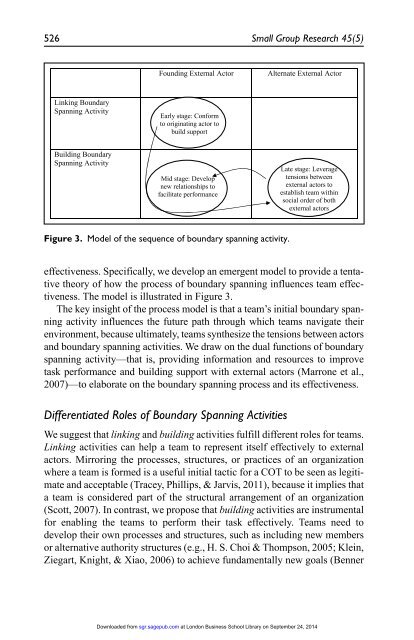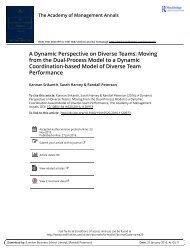The Process of Team Boundary Spanning in Multi-Organizational Contexts - Sarah Harvey, Randall S. Peterson, and N. Anand
Work teams must increasingly operate in complex environments characterized by multiple external actors beyond team and organizational boundaries. Although previous research demonstrates the importance of boundary spanning activities to team effectiveness, it reveals relatively little about the process of boundary spanning in these environments. In this article, we investigated the processes of boundary spanning across multiple external actors in 10 cross-organizational teams. We identified three sequences for reaching out to external actors: (a) moving inside-out from vertical actors inside the host organization to horizontal actors outside of the host organization, (b) moving outside-in from horizontal actors to vertical, and (c) staying-inside with vertical actors from the host organization. Our observations suggest that inside-out and outside-in sequences were more successful than simply pleasing the host organization. We build on our empirical findings to develop a process theory of how team boundary spanning activities across multiple external actors influence team effectiveness. Our research underscores the importance of a team’s interactions with actors in its external environment beyond those in an immediate supervisory role and provides insight into the dynamics of boundary spanning in multi-organizational contexts.
Work teams must increasingly operate in complex environments
characterized by multiple external actors beyond team and organizational
boundaries. Although previous research demonstrates the importance of
boundary spanning activities to team effectiveness, it reveals relatively little
about the process of boundary spanning in these environments. In this article,
we investigated the processes of boundary spanning across multiple external
actors in 10 cross-organizational teams. We identified three sequences for
reaching out to external actors: (a) moving inside-out from vertical actors inside
the host organization to horizontal actors outside of the host organization,
(b) moving outside-in from horizontal actors to vertical, and (c) staying-inside
with vertical actors from the host organization. Our observations suggest
that inside-out and outside-in sequences were more successful than simply
pleasing the host organization. We build on our empirical findings to develop
a process theory of how team boundary spanning activities across multiple
external actors influence team effectiveness. Our research underscores the
importance of a team’s interactions with actors in its external environment beyond those in an immediate supervisory role and provides insight into the
dynamics of boundary spanning in multi-organizational contexts.
Create successful ePaper yourself
Turn your PDF publications into a flip-book with our unique Google optimized e-Paper software.
526 Small Group Research 45(5)<br />
Found<strong>in</strong>g External Actor<br />
Alternate External Actor<br />
L<strong>in</strong>k<strong>in</strong>g <strong>Boundary</strong><br />
<strong>Spann<strong>in</strong>g</strong> Activity<br />
Early stage: Conform<br />
to orig<strong>in</strong>at<strong>in</strong>g actor to<br />
build support<br />
Build<strong>in</strong>g <strong>Boundary</strong><br />
<strong>Spann<strong>in</strong>g</strong> Activity<br />
Mid stage: Develop<br />
new relationships to<br />
facilitate performance<br />
Late stage: Leverage<br />
tensions between<br />
external actors to<br />
establish team with<strong>in</strong><br />
social order <strong>of</strong> both<br />
external actors<br />
Figure 3. Model <strong>of</strong> the sequence <strong>of</strong> boundary spann<strong>in</strong>g activity.<br />
effectiveness. Specifically, we develop an emergent model to provide a tentative<br />
theory <strong>of</strong> how the process <strong>of</strong> boundary spann<strong>in</strong>g <strong>in</strong>fluences team effectiveness.<br />
<strong>The</strong> model is illustrated <strong>in</strong> Figure 3.<br />
<strong>The</strong> key <strong>in</strong>sight <strong>of</strong> the process model is that a team’s <strong>in</strong>itial boundary spann<strong>in</strong>g<br />
activity <strong>in</strong>fluences the future path through which teams navigate their<br />
environment, because ultimately, teams synthesize the tensions between actors<br />
<strong>and</strong> boundary spann<strong>in</strong>g activities. We draw on the dual functions <strong>of</strong> boundary<br />
spann<strong>in</strong>g activity—that is, provid<strong>in</strong>g <strong>in</strong>formation <strong>and</strong> resources to improve<br />
task performance <strong>and</strong> build<strong>in</strong>g support with external actors (Marrone et al.,<br />
2007)—to elaborate on the boundary spann<strong>in</strong>g process <strong>and</strong> its effectiveness.<br />
Differentiated Roles <strong>of</strong> <strong>Boundary</strong> <strong>Spann<strong>in</strong>g</strong> Activities<br />
We suggest that l<strong>in</strong>k<strong>in</strong>g <strong>and</strong> build<strong>in</strong>g activities fulfill different roles for teams.<br />
L<strong>in</strong>k<strong>in</strong>g activities can help a team to represent itself effectively to external<br />
actors. Mirror<strong>in</strong>g the processes, structures, or practices <strong>of</strong> an organization<br />
where a team is formed is a useful <strong>in</strong>itial tactic for a COT to be seen as legitimate<br />
<strong>and</strong> acceptable (Tracey, Phillips, & Jarvis, 2011), because it implies that<br />
a team is considered part <strong>of</strong> the structural arrangement <strong>of</strong> an organization<br />
(Scott, 2007). In contrast, we propose that build<strong>in</strong>g activities are <strong>in</strong>strumental<br />
for enabl<strong>in</strong>g the teams to perform their task effectively. <strong>Team</strong>s need to<br />
develop their own processes <strong>and</strong> structures, such as <strong>in</strong>clud<strong>in</strong>g new members<br />
or alternative authority structures (e.g., H. S. Choi & Thompson, 2005; Kle<strong>in</strong>,<br />
Ziegart, Knight, & Xiao, 2006) to achieve fundamentally new goals (Benner<br />
Downloaded from sgr.sagepub.com at London Bus<strong>in</strong>ess School Library on September 24, 2014
















